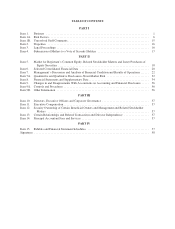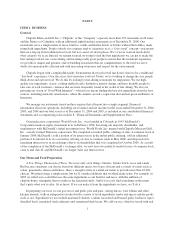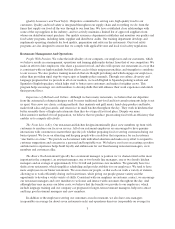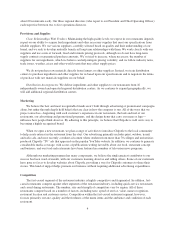Chipotle 2006 Annual Report Download - page 16
Download and view the complete annual report
Please find page 16 of the 2006 Chipotle annual report below. You can navigate through the pages in the report by either clicking on the pages listed below, or by using the keyword search tool below to find specific information within the annual report.policies with modified coverage. Prior to entering into the new policies, we were covered by fixed cost policies
for health insurance and workman’s compensation. We are now self-insured for our health plans, and have
purchased a fully-insured stop loss policy to help offset our liability for both individual and aggregate claim
costs. We are also responsible for losses up to a certain limit for workers’ compensation, general liability and
property damage insurance.
For policies under which we are responsible for losses, we record a liability that represents our estimated
cost of claims incurred and unpaid as of the balance sheet date. Our estimated liability is not discounted and is
based on a number of assumptions and factors, including historical trends, actuarial assumptions and economic
conditions, and is closely monitored and adjusted when warranted by changing circumstances. Our history of
claims experience is short and our significant growth rate could affect the accuracy of estimates based on
historical experience. Should a greater amount of claims occur compared to what was estimated or medical costs
increase beyond what was expected, our accrued liabilities might not be sufficient and we may be required to
record additional expense. Unanticipated changes may produce materially different amounts of expense than that
reported under these programs, which could adversely impact our results of operations.
We may not persuade customers of the benefits of paying our prices for higher-quality food.
Our success depends in large part on our ability to persuade customers that food made with higher-quality
ingredients is worth the prices they will pay at our restaurants relative to prices offered by some of our
competitors, particularly those in the quick-service segment. We may not successfully educate customers about
the quality of our food, and customers may not care even if they do understand our approach. That could require
us to change our pricing, advertising or promotional strategies, which could materially and adversely affect our
results or the brand identity that we have tried to create.
Changes in customer tastes and preferences, spending patterns and demographic trends could cause sales
to decline.
Changes in customer preferences, general economic conditions, discretionary spending priorities,
demographic trends, traffic patterns and the type, number and location of competing restaurants affect the
restaurant industry. Our success depends to a significant extent on consumer confidence, which is influenced by
general economic conditions and discretionary income levels. Our sales may decline during economic downturns,
which can be caused by various economic factors such as high gasoline prices, or during periods of uncertainty,
such as those that followed the terrorist attacks on the United States in 2001. Any material decline in consumer
confidence or a decline in family “food away from home” spending could cause our sales, operating results,
profits, business or financial condition to decline. If we fail to adapt to changes in customer preferences and
trends, we may lose customers and our sales may deteriorate.
Competition from other restaurant companies could adversely affect us.
The fast-casual, quick-service and casual dining segments of the restaurant industry are highly competitive
with respect to, among other things, taste, price, food quality and presentation, service, location and the ambience
and condition of each restaurant. Our competition includes a variety of restaurants in each of these segments,
including locally owned restaurants and national and regional chains. Our competitors offer dine-in, carry-out
and delivery services. Many of our competitors have existed longer and often have a more established market
presence with substantially greater financial, marketing, personnel and other resources than we have. Among our
main competitors are a number of multi-unit, multi-market Mexican food or burrito restaurant concepts, some of
which are expanding nationally. As we expand further in existing markets, our existing restaurants may face
competition from our new restaurants that begin operating in those markets.
Several of our competitors compete by offering menu items that are specifically identified as low in
carbohydrates, better for customers or otherwise targeted at particular consumer preferences. Many of our
10
























